UAE
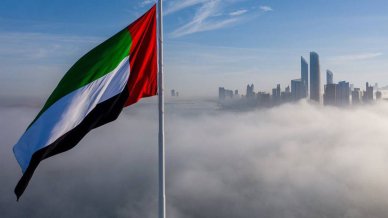
The standard and quality of life in this country resemble the ones of an Arabian fairy tale. However, 50 years ago, it was one of the numerous British colonies, deprived of rights and freedoms and unable to take charge of enormous oil deposits in its territory.
Much has changed since then. Nowadays, the United Arab Emirates is one of the most prosperous states of the Arab world. There is the record number of local dollar millionaires: every hundredth Emirati has a six-figure sum in their bankroll.
People come here to work and earn. It comes as no surprise that the indigenous inhabitants make only 15% of the five-million population. The others are foreign workers and employees of oil companies.
People also come here to spend a holiday. Eternal summer, a highly developed tourism industry, and excellent infrastructure have created perfect conditions for recreation all year round.

General Information
The UAE is an excellent example of a country that has managed to get rid of internal government and take control of its own economic, cultural, and religious policies.
Historical Background
There had been several sheikhdoms (principalities) on the territory of the modern Arab Emirates before the 1920s. At the beginning of the 16th century, they were under the influence and protectorship of European countries. At different times, the sheikhdoms were controlled by Portugal and British Empire. Portuguese supremacy was short-time and insignificant, but Britain, in its turn, established a total protectorate for the following 200 years. Apart from a political impact, the British installed their military bases, administered pearl fishing and trade with foreign countries.
In 1922, the Middle East was the place of discovery of enormous oil reserves. Britain, as it always did, took control of this sphere too. And field survey and oil extraction aroused particular interest. In the 1960s, the life of poor Arabian sheikhdoms improved considerably at the expense of oil revenues. However, the Arab League considered ceasing protectorate and demanded complete independence for the sheikhdoms.
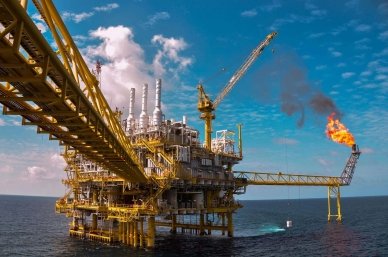
Offshore oil platform in the UAE
Between 1968 and 1971, Britain had no choice but to refuse to govern such a sweet spot of Arabian land, saturated with oil and big money.
There formed the federation of several principalities on the coast of the Persian Gulf. The plan was to unite eight of them: six emirates, Bahrain, and Qatar. But the latter two reconsidered that at the last moment and decided to build their own independent states.
As a result, on December 2, 1971, a new state, the United Arab Emirates, emerged on the world map. First, it consisted of six principalities, and the seventh acceded to the UAE in a year.
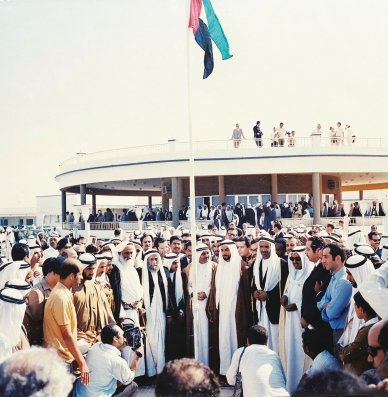
Sheikh Zayed, raises the flag at Union House in Dubai on December 2, 1971, to mark the formation of the UAE
The newly-formed state was lucky enough. At the beginning of the 1970s, there was a sharp spike in oil prices. Thus, the influx of petrodollars into the Emirates was so massive that, together with a rational government policy, it provided a major impetus for national economic development.
Nowadays, the Arab Emirates boasts not only a highly developed oil industry. Tourism and the financial sphere are the other two pillars that have supported national welfare and independence for 50 years.
Geography and Climate
The United Arab Emirates occupies a part of the Arabian Peninsula, which is the biggest in the world and located in southeast Asia. The country has marine boundaries with the Persian Gulf, Qatar, Iran, and terrestrial — with Saudi Arabia and Oman.
This Middle East federation consists of seven emirates, which, by nature, are absolute monarchy microstates governed by emirs:
- Abu-Dhabi,
- Dubai,
- Ras Al Khaimah,
- Fujairah,
- Ajman (the smallest emirate),
- Umm Al Quwain,
- Sharjah.
The biggest emirate is Abu-Dhabi, where the capital city is. The Emir of Abu-Dhabi is also the UAE President.
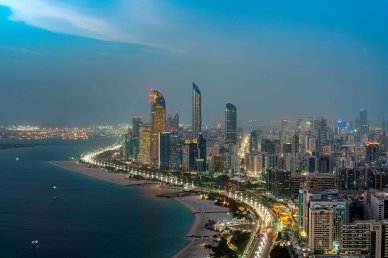
Abu-Dhabi at night
There are only a few inhabited areas in the Emirates. The Rub’ al Khali desert occupies most of the country and occasionally brings sandstorms, making the lives of the citizens more difficult.
The UAE climate is about the heat all year round that falls off only in winter. In summer, it is scorchingly hot (+45°C - +50°C), and during winter months, the day temperatures range from +20°C to +25°C. Very rarely, the weather can be freezing at night.
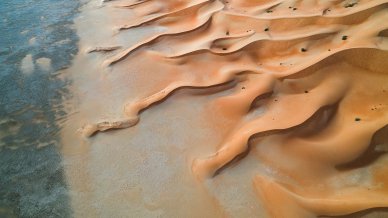
Winding sand dunes on the edge of the desert, Rub Al Khali, UAE
The heat makes its own adjustments in the country’s life. All public transport stops are equipped with air conditioning, which is extremely important both outside and inside. Desalination plants are the key water providers, and its consumption increases because of the heat. As a result, the sums of utility fees become huge, including electricity. Anyway, the high salaries of local people compensate for this expensiveness. For example, the average salary of civil servants is around $10,000.
Population, Language, and Currency
Perhaps, there is no other country in the world as the UAE, where the native population accounts for only 15% of the total number of people living there. The others are migrant workers from entire Asia. Pakistani, Indian, Bangladeshi, Egyptian, and Philippine immigrants traditionally arrive to work at the oil platforms.
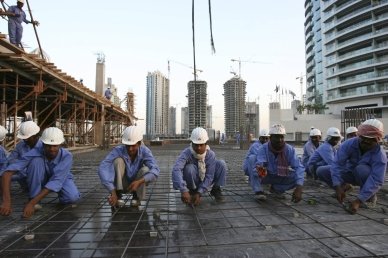
Foreign workers at a construction site in Dubai
The official language is Arabic, but local people can also speak English.
Interestingly, the national government has a parent-like treatment towards its citizens. The entire world may be jealous of the UAE’s social policy. For example, every young family obtains an enormous house and $20,000, a truly royal gift.
The birth of a son is not only an exciting pleasure for the whole family but a perfect way to boost the family budget. The state pays $50,000 for a family for every newly-born boy. By the way, this policy has been adopted by the governments of the other Arab countries, like Kuwait, Bahrain, and Oman, where the profits from oil extraction make the lion’s share of the national budget.
The UAE is a Muslim country, and up to 99% of its residents adhere to Islam. It leaves an imprint on their mentality, rules, and way of life. In this country, women should use the bus, underground, and even taxi separately from men. Moreover, local females never wear short dresses and trousers.
Interestingly, in the UAE, mosques are not tourism objects, and only Muslims can come inside to utter their prayers.
They do not sell alcohol in the United Arab Emirates. Foreign tourists may buy one or two bottles of beer at hotel restaurants, but only if they drink it within the hotel premises. Walking when intoxicated is not a good idea as it poses a threat of arrest and imprisonment.
In the Emirates, locals treat non-Muslim tourists very well. However, they always want them to respect and obey Muslim laws and not abuse their hospitality.
The biggest UAE city is not its capital. Abu-Dhabi holds the third position (1.5 million people). The first place is taken by Dubai (2.5 million people), and the second — by Sharjah (1.6 million people).
The official currency is the UAE dirham (AED). The AED-USD exchange rate is 1:0.27, and AED-EUR is 1:0.23.
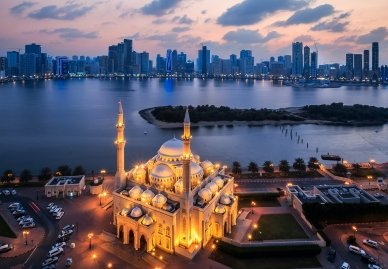
Sharjah, United Arab Emirates
Directions
The UAE is a perfect place for recreation and business trips. That is why air connectivity has been set going, and the only way to get to Dubai is to buy an air ticket.
There are many direct flights from Europe. Usually, they take five hours or longer and cost around $250 or more.
The national airlines are Etihad Airways, based in Abu-Dhabi. There are also some other companies like FlyDubai, Emirates, AirArabia, Royal Jet, etc.
Many tourists opt for travelling by cruise ships, and in the UAE, the seaports provide all necessary facilities and infrastructure.
International air flights are serviced by two airports — Dubai and Al Maktoum International Airports.
Entry requirements often change due to the ongoing pandemic, so it will be essential to double-check them before the departure to the United Arab Emirates on the embassy website.

Accommodation
If your soul longs for plenty of sunshine and something exotic within an absolutely comfortable environment for having rest, there is nothing better than a trip to the United Arab Emirates. Normally, it does not cost much but leaves overriding impressions.
Undoubtedly, buying a package holiday at a travel agency is much better as they will deal with all problems related to accommodation, food, and sightseeing. However, a self-organised tour is not worse. It is essential to be aware and take into consideration some peculiarities connected with spending a vacation in this Middle East country. And the choice of accommodation, restaurants, and types of entertainment is extensive.
The hotel occupancy in the United Arab Emirates varies by season and the calendar of Muslim holidays. These things also impact the price range. It is considered that the best vacation time for Europeans begins at the end of September and ends in April, which is the period without scorching heat but with the sea warm enough. For example, Turkey during that season will be quite chilly, with cold water, and only the most desperate tourists would dare to go there.
However, the prices for package holidays and hotel rooms are much higher between September and April than in other seasons. Besides, the cost also depends on hotels’ remoteness from the beach. Nonetheless, even during the peak of the season, there are budget-friendly hotels.
Based on tourists’ feedback, good and inexpensive rooms can be found within Dubai’s Deira in such chain hotels as Ibis, City Max, etc. Spending a holiday in Sharjah also evokes much interest. Local suites and beaches are well-known for moderate prices and high-quality services.
The other option is Ras Al Khaimah. Artificial Al Marjan islands, located in the very northern UAE emirate, welcome hundreds of thousands of visitors annually. More than 50% of hotel rooms available within the archipelago are in five-star international hotel chains like Bab-al-Bahr, Rixos, Hilton, and others.
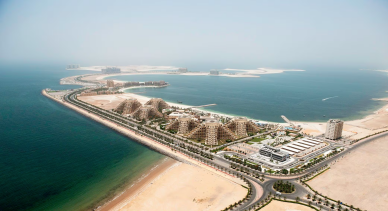
Marjan Island in Ras Al Khaimah
Below are several accommodation options:
- Majlis Grand Mercure Residence Abu Dhabi, located in the capital, is a five-star hotel with open swimming pools, fitness clubs, and restaurants within the premises. All the rooms are equipped according to the requirements for the hotel suits of high level. There is also free Wi-Fi.
- Pullman Sharjah is a luxurious five-star skyscraper in Sharjah that offers stylish and expensively furnished rooms that correspond to the requirements for luxury suites. There are swimming pools, fitness clubs, SPAs, restaurants, and a free car park within hotel premises and buildings. Wi-Fi is also free.
- Crystal Plaza Hotel is a three-star hotel in Sharjah outskirts that welcomes its guests with stylish rooms, comfortable beds, and other quality furniture. There are restaurants, SPAs, a free car park, and swimming pools. The hotel also offers an airport shuttle service.
- Al Nakheel Hotel Apartments is a three-star hotel in Ras Al Khaimah. The living conditions are good enough: there is a kitchenette with a basic set of dishware, a microwave, and a coffee machine in each room. The Internet access and a car park are free of charge.
- Grand Sina Hotel in Deira, Dubai, offers rooms for two or more people. There are comfortable beds, fresh bed linen, and bathrooms with showers. The guests may also visit a restaurant situated on the first floor. The hotel is located not far from big shopping malls and Lebanese eateries.
It is not difficult to rent accommodation in the UAE due to the multitude of offers. But there are still some subtleties that may become a problem for non-residents. Before moving to the rented apartment, it will be necessary to tap into electricity, water supply, and Internet access. However, those things can become possible only after signing an official agreement, and only those who have the permanent residence permit are entitled to do it.
It is impossible to rent accommodation for a week or two here. You may start negotiating a deal with a landlord only if tenancy lasts six months or longer; a one-year period is even better. As it has been mentioned, the expenses on utilities, like Internet access, water and electricity supply, are considerable. For example, the latter two will cost around $130 per month, and renting a flat with one bedroom will range from $10,000 to $20,000 a year. The price typically depends on the neighbourhood and other details.
Apparently, it is not cost-effective to live in a rented apartment compared to a hotel. So if your stay in the UAE is short-term, do not even make an effort to search for rental options.
Places to See
Do you know what Arabian luxury is? It is about selling gold by weight in kilograms, not as a piece of jewelry. It is also about the fountains shooting 150 m high with opalescent water columns of incredible beauty when the country experiences water shortage. And it is about a mountain ski resort in the middle of the desert that welcomes visitors to go skiing and snowboarding.
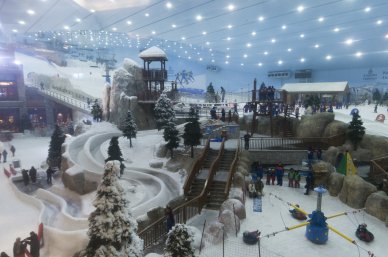
The 280-foot-tall artificial mountain is located in Dubai and includes an adjacent snow park
The list of the UAE wonders that astonish tourists from around the world is very long. So let us single out the most spectacular attractions of the Emirates.
Burj Khalifa
It was not the USA, the homeland of skyscrapers, where the world’s tallest construction emerged. The well-known Empire State Building lost this status long ago, in 1970. Nowadays, the top position is taken by an 828-metre giant consisting of 163 floors, built in 2010 in Dubai.
Architecturally, the tower resembles a stalagmite and comprises a multitude of offices, stores, restaurants, luxurious suites, and even an entire complex of fountains.
The other reason to go on a tour is to spectate the breathtaking panoramas of Dubai from the skyscraper’s viewing decks.
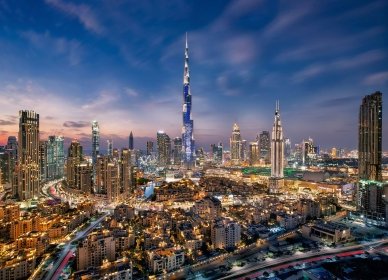
Burj Khalifa, Dubai
Dubai Gold Souk
Dubai is about excitement on the verge of shock. The abundance of white, yellow, and rose gold sold loose in one of the shopping districts resembles a cave full of treasures as described in the Arabian fairy tale about Ali Baba.
They do not know what it means to sell pieces of jewellery per item, and they weigh it in kilograms. The secret is that, in the UAE, gold is inexpensive owing to the elaborate tax policy, so those fond of the shine of precious metals come here from every corner of the globe.
Even the Emirati themselves visit this place from time to time, particularly the men getting ready to propose to their fiancées. According to the tradition, future husbands will get a positive response from the brides only in exchange for at least five kilograms of golden jewellery.
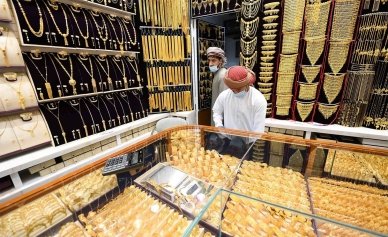
Store at Dubai Gold Market
Mosques
Every mosque in the United Arab Emirates is a true masterpiece of Islamic architecture. Only the most expensive stone, gold leaf, and luxurious carpets are usually used during construction.
Sheikh Zayed Mosque is a snow-white wonder built in Abu Dhabi to pay tribute to the UAE founder buried there. It is among a few open for tourists of different religious faiths who can come and spectate it with astonishment.
It has a record capacity of 40,000 praying people at once. And no other religious construction in the world can accommodate such a number at a time. The mosque floor is covered with a huge carpet of 5,600 square metres. The lighting system incorporates a chandelier containing thousands of Swarowski crystals. It was considered the largest in the world till 2010, weighing 12 tons, having a height of 15 metres and a diameter of 10 metres.
Getting there is possible by number 32, 44, or 54 buses leaving at the central bus station. You will need to get off at the Zayed Mosque bus stop. The working hours are from 9 a. m. to 12 p. m. from Saturday to Thursday. The admission is free of charge.
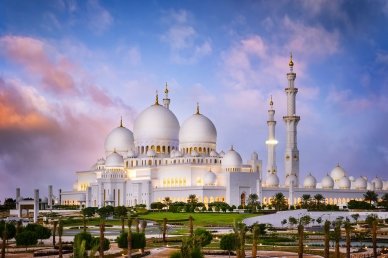
Sheikh Zayed Mosque, Abu Dhabi
In Dubai, one more mosque is open for attendance by non-Muslim tourists - Jumeirah. The rules for visitors are the same: daily from 9 a. m. to 12 p. m., except Friday, and without the charge for admission. Jumeirah Mosque is located in the coastal residential area, not far from the beach to the west.
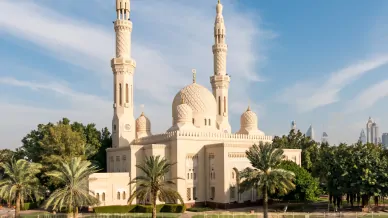
Jumeirah Mosque is the only mosque in Dubai open to non-Muslim visitors
In Sharjah, there is King Faisal Mosque, but remember that this emirate is very strict in terms of compliance with Sharia Law. Thus, it will be impossible to get inside. However, a guided tour of the outside will bring no less excitement and pleasure: the architecture will impress with its might and magnificence.
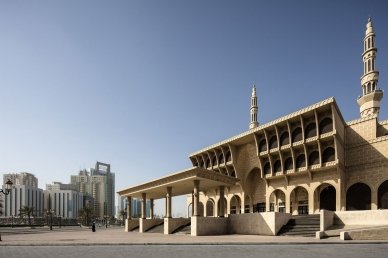
King Faisal Mosque, Sharjah
Forts
The UAE fortification constructions retain the memory of battles and wars that took place on the territory of the future oil empire several centuries ago.
The forts were built in oases that needed protection from hostile invasions. A variety of materials were used for construction, for example, coral stone, gypsum, African timber species.
The other forts of interest are Al Jahili (Al Ain), Ajman (Ajman), Al Fahidi (Dubai), and Al Hisn, which was a residence for the family of the Sharjah emir and a prison at the same time.
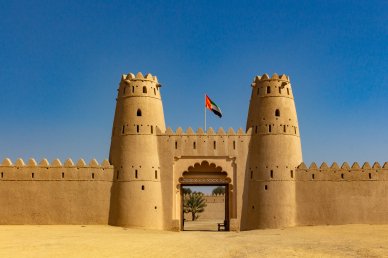
Al Jahili (Al Ain) fort, Abu Dhabi, the UAE
Sir Bani Yas Island
A guided tour of the national park, established by Sheikh Al Nahyan, is quite an event for those in love with wild nature. It is a habitat for hundreds of species of rare animals and birds sheltered by the island’s eight million trees all year round.
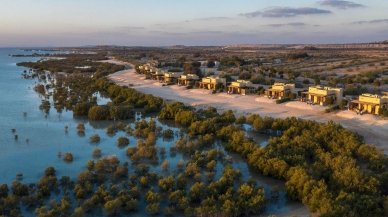
Anantara Sir Bani Yas Island Al Yamm Villa Resort
You may get there by car or take a taxi to Abu Dhabi ferry crossing, and then travel to this destination by ferry.

Sir Bani Yas Island National Park
Jeep Races in the Desert
This type of entertainment will be an excellent option for the most adventuresome individuals seeking a thrill. Undoubtedly, the drivers are only locals who know the area and driving process inside out. Tourists may take part in a race as passengers.
Heavy quicksands pose many threats as there is a risk of falling into a bottomless hole at any moment, and nobody knows how it was formed in the middle of the road. Actually, one can hardly call those beaten tracks the roads. They get filled with the sand immediately, and you may only guess where to go further. But a local Arab man knows the route in detail and can deal with any trouble.
Regardless of the skillfulness of drivers, this kind of safari may cause accidents. And every thrill-seeker is usually warned about that. Besides, it is essential to know that insurance policies do not cover the injuries obtained during the desert races.
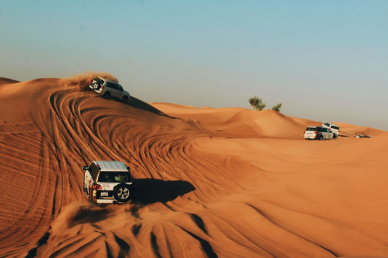
Dubai Desert Safari
Normally, one race takes five or six hours and ends with camel riding, belly dances, and dinner in Bedouin villages, where all cars eventually arrive. The races may take place in the morning or in the evening, and the cost usually ranges from $25 to $50 per person. It is better to book the tickets in advance while buying a package holiday to the UAE to save money because it will be $5-$10 pricier upon arrival.
Food
Having tasted the dishes of local cuisine, you will kill two birds with one stone. It means getting familiarised with the Emirati and Lebanese food at once. Lebanon borders Syria, the UAE’s neighbouring country. As a result, most part of the Emirates’ menu consists of the dishes borrowed from the Lebanese.
Anyway, if you do not fancy exotic Oriental food, you will definitely come across traditional Big Macs, meat, and vegetable salads. There are plenty of restaurants that offer menus with European, American, and Asian dishes.
As the UAE is a Muslim country, you will need to consider local peculiarities that are directly related to the religious canons. Firstly, they do not serve pork dishes in the Emirates despite a tolerant attitude towards non-Muslim tourists. Secondly, a package holiday during the holy month of Ramadan is very specific. Muslims cannot eat from dawn to sunset, so most authentic restaurants open after 8 p. m. Tourists may have a snack only at some cafes, but their windows will be with the blinds drawn.
However, after 8 p. m., the local catering industry begins to buzz with activities. The waiters are run off their feet serving meals to lots and lots of hungry visitors.
Though alcohol is allowed, drinking is extremely expensive in the United Arab Emirates. In addition, tourists cannot drink spirits outside the hotel premises as a strict punishment may be imposed.
So what is worth tasting in the Emirates? Meat is the answer. The way it is cooked here is unimitable in any other part of the world. Exquisite beef, veal, mutton, and chicken dishes impress with aromas and tastes. For example, you will be delighted with guzi — tender lamb meat with nuts and raisins.
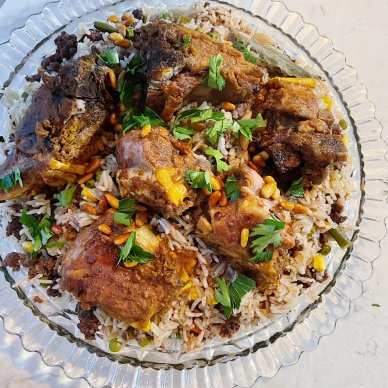
Ouzi (guzi) Lamb with Spiced Rice
You should definitely try biryani — a national variety of layered pilaff. The sequence of layers is as follows. First, herbs and spices are fried to get the best flavours and put onto a big plate. The next stage is frying the sliced chicken and lamb and laying them over the first layer. And the final thing is to put a pile of Basmati rice covered with mouth-watering meat.
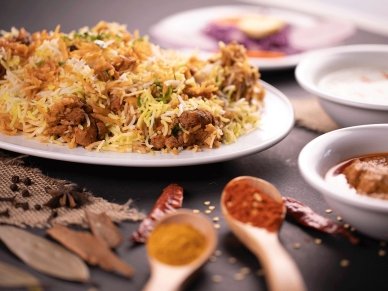
Mutton biryani
Fish lovers will like briki — layered triangular pies filled with fish or shrimps. They are usually eaten with lemon and green stuff to add to the piquant sourness.
The first courses of Arabian cuisine are so filling that the second ones may not be necessary. In the UAE, they complement meat broth with chickpeas, peas, beans, and potatoes to make it very thick. As a rule, these soups are served with small pies filled with meat, fish, green stuff, and vegetables.
As appetizers, the Emirati serve meze — small dishes of meat or cheese cold cuts, vegetable salads, caviar, wheat or maize porridges, or small vegetables.
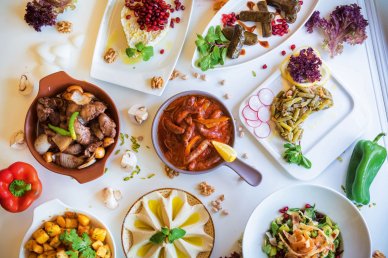
Meze in Abu Dhabi
You may also try hummus, mashed chickpeas mixed with tahini (ground sesame with olive oil and spices).
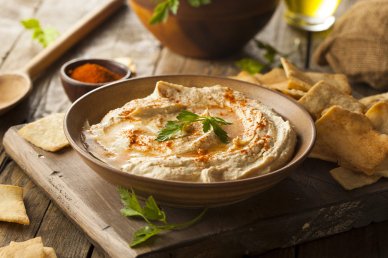
Hummus
Desserts are usually about a range of oriental delights like lokum, halva, and dates. However, there are less known delicacies. For example, you may enjoy Aish el Saraya cheesecake, crispy doughnuts with cream, and legends of Dubai’s confectionary — exquisite cakes with extraordinary decorations.
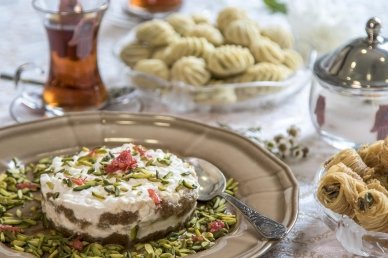
Aish el Saraya
Those goodies can be followed by sherbet, a sugary fruit drink, or a cup of coffee of different strength, depending on personal preferences.
The United Arab Emirates is a perfect place for those in pursuit of miracles, luxury, and beautiful life. Nowhere else but here can you realise that every dream becomes true, just put your mind to it.
FAQ
What are the 7 UAE states?
The 7 emirates of the UAE are Abu Dhabi, Dubai, Sharjah, Ajman, Fujairah, Ras Al Khaimah, and Umm Al Quwain.
What is the total area of UAE?
The total area of the UAE is approximately 83,600 square kilometers.
Is UAE a country or Dubai?
The UAE (United Arab Emirates) is a country, and Dubai is one of its seven emirates.
Is the language in the UAE Arabic or English?
The official language of the UAE is Arabic, but English is widely spoken and used in business and tourism.
What is the capital city of the UAE?
The capital city of the UAE is Abu Dhabi.
What is the population of UAE?
The population of the UAE is around 9.9 million people.
What are the top 3 ethnicities in UAE?
The top three ethnic groups in the UAE are Emirati (local citizens), South Asian (Indian, Pakistani, Bangladeshi), and Egyptian and Filipino expatriates.
What is the main religion in UAE?
The main religion in the UAE is Islam.
What type of government is UAE under?
The UAE is a federal absolute monarchy. It is governed by a council of rulers from the seven emirates, with a President and a Prime Minister.
Who is ruling UAE now?
The President of the UAE is Khalifa bin Zayed Al Nahyan, and the Prime Minister is Mohammed bin Rashid Al Maktoum.
How is the economy in UAE?
The UAE has a diversified economy, known for oil and gas production, real estate, tourism, and financial services, contributing to its high GDP per capita.
What is UAE currency?
The currency of the UAE is the United Arab Emirates Dirham (AED).
What is the UAE best known for?
The UAE is known for its oil wealth, modern cities like Dubai and Abu Dhabi, luxury shopping, ultramodern architecture, and a thriving business hub.
Who can visit UAE without a visa?
Citizens of GCC countries can enter the UAE without a visa. Many other nationalities can obtain a visa on arrival, while others need to apply for a visa beforehand.
Is UAE good for tourists?
Yes, the UAE is a popular tourist destination, known for its luxury resorts, shopping malls, cultural attractions, and modern infrastructure.
What is the crime rate in UAE?
The UAE has one of the lowest crime rates in the world, largely due to strict laws and effective law enforcement.







